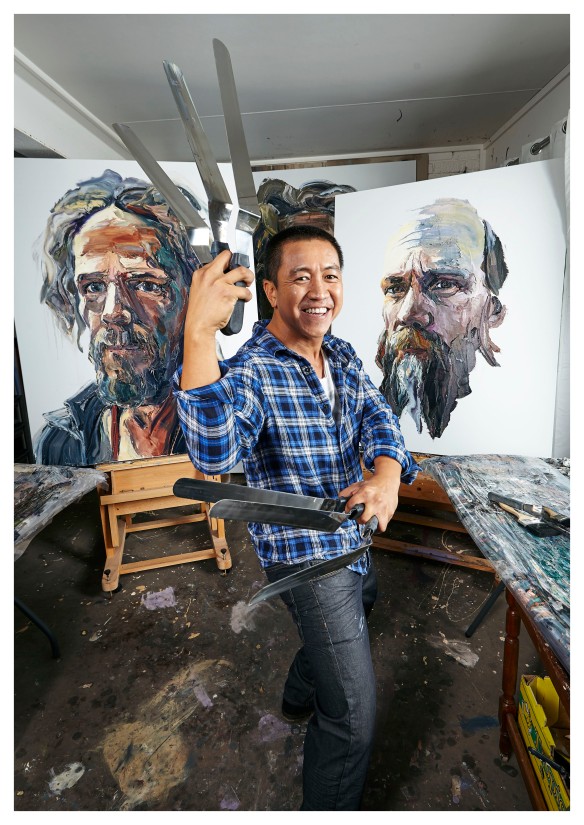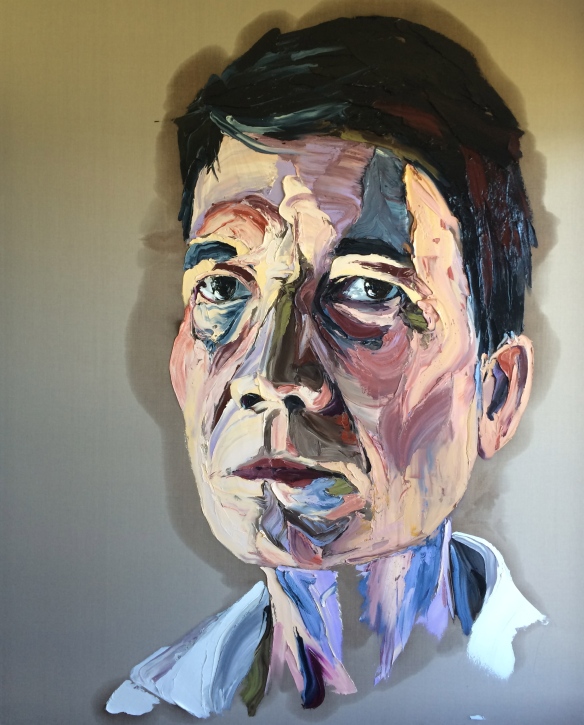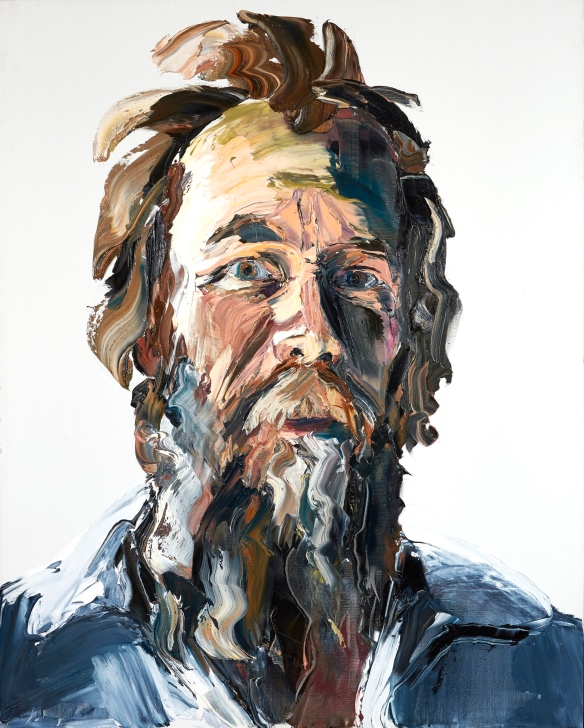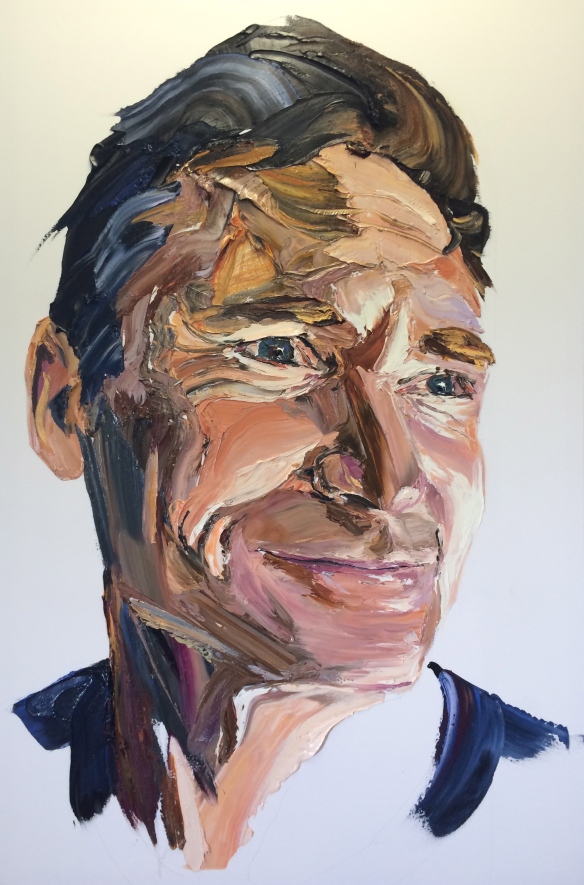
Anh Do in his studio with two of the portraits in his first solo exhibition Man. Photo: Eamonn McLoughlin
When the finalists for last year’s Archibald Prize were announced, many were surprised to see that comedian Anh Do was represented with a portrait of his father.
Do himself was utterly thrilled: “Just to walk into the Art Gallery of NSW and see what was sitting in your garage a few weeks earlier hanging up there was wonderful,” he says.
“The woman who hung the exhibition said, ‘I hope you like the spot, Anh.’ I said, ‘I’m just so thankful. I’d be happy to be hung anywhere in the Archibald. I’d take cubicle three of the men’s.”
It was no flash in the pan either. Do won the 2014 Kogarah Art Prize with another portrait and currently has his first solo exhibition at Olsen Irwin in Woollahra, one of Sydney’s leading commercial art galleries.
Do famously arrived in Australia at age three as a refugee when his family fled strife-torn Vietnam in a leaky boat. Drawing on his life story in his stand-up shows, he has become one of Australia’s best-loved comedians, filling venues and popping up on TV programs such as Thank God You’re Here and Dancing With the Stars on which he was the runner-up in 2007.
Russell Crowe is going to direct a film based on Do’s award-winning autobiography The Happiest Refugee for which Do has been working on the screenplay and will play his own father.
In between all that, he now spends much of his time painting in a large garage at his home on the Illawarra coast where he lives with his wife Suzie and their four children.
The solitary hours spent applying thick oils to canvas suits his temperament.
“People who know me will tell you that I’m more of an introvert than people think. Actually, a lot of comedians are and it surprises people,” he says, chatting at his home with its view of the ocean.
“I love being on stage and connecting with 2000 people but you don’t really see me that often at the Logies and all that red carpet stuff. I’d rather just have dinner with my wife and kids.”
Do has always loved art but has come to it relatively late – partly because his father, who was an alcoholic, walked out on the family when Do was 13. He didn’t see his father again until he was 21, though they are now very close.
“As a kid I loved art, loved it,” he says. “But somewhere along the line in school I stopped taking art classes because people told me if you want to get high marks in the school certificate don’t do art.
“My mum raised three kids on her own on sweatshop wages of about six bucks an hour so there was a lot of late rent and landlords knocking on the door,” recalls Do.
“When I was about 10 I remember thinking, ‘one day I’m going to buy a big house we can all live in together and we’ll never have to be hassled by landlords again’. So I went to school and asked around and said, ‘guys what’s the job that pays the most money?’ and someone said, ‘lawyers get loads’ and so I thought ‘that’s what I’m going to be’.”
Do got into Law at university. “But I couldn’t help myself. I signed up to study art at TAFE simultaneously. You can’t really do both so I ended up skipping all the law classes because they were really boring and going to all the art classes. Then, of course, comedy came along and wiped both out,” he says.
“But about four or five years ago, a comedian mate called Dave Grant passed away and a cousin of mine passed away in his late 20s. I always thought I’d paint one day after I retire, buts something made me go, ‘you know what, I’ve got to do it now’. So I went back to TAFE.”
His solo show, entitled Man, features a series of portraits, many of them with a haunting gaze similar to that of his father in his Archibald painting.
“These guys that I’ve painted, they’re lived a full life and they’ve had their ups and downs and it shows in their eyes. That’s what interests me,” says Do.
“A lot of being a comedian is about observing people. When I’m on stage I look at people in the audience. It might be 2000 people in the State Theatre but I’ll look at a few people and make eye contact with them. It’s an incredibly powerful connection for two people who have never really met properly.
“I’m interested in everything about people. Not just, ‘what do you do for a living?’ but I want to know about their fears and their sadnesses and listen to their regrets and all of that, both sides of it, the happy and the sad. A lot of my work is driven by what makes people human.
“Years ago my comedy used to just be funny gags strung together with dodgy segues but recently I’ve been delving into my childhood so some stories make people laugh and other make people cry. My comedy shows these days are so much richer for the fact that there’s laughter and tears in the audience.”
Do credits fellow comedian Dave Hughes with encouraging him to draw on his own experience.
“A couple of years ago me and Hughesy had just finished filming Thank God You’re Here. We were just hanging out and I started telling him real life stories and he goes, ‘mate, this stuff is fascinating, you should tell it on stage,” recalls Do.
“I said to Hughesy, ‘I want to make people laugh not cry’ and he said, ‘Anh, make ‘em laugh and cry.’ That’s probably why I started mixing in all that real life story so I have Hughesy to thank for my show becoming richer and deeper.”
Hughes was one of the first people Do painted. He entered the portrait into the Swan Portrait Prize in Perth and was selected as a finalist.
Do says that now that he paints regularly, he notices things he never did before.
“I used to look at a rusty old tap and it’s just a rusty old tap but now I see 15 shades of brown and orange and there’s even a lot of green and a couple of shades of purple. Before, it was a rusty old tap, now it’s a beautiful array of colour. These days, I can tell you the eye colours of most of my good friends. Before that I’d be stumped.”
Do has been performing his comedy show The Happiest Refugee Live for three years now but there is so much demand for it that he will take it on another national tour in May and June.
“It’s not just stand-up. There are videos and pictures and props on stage. It’s almost a theatre show,” he says.
It’s certainly an inspiring story – as is Do’s positive outlook on life.
“When we were at sea (en route to Australia) we ran out of food and water and we could easily have died,” he says. “My mum always taught us as kids that we are lucky just to be alive so you may as well make your life worth something, throw something into the hat and contribute.”
Do’s exhibition Man runs at Olsen Irwin Gallery in Woollahra, Sydney until May 10
A version of this story ran in the Sunday Telegraph on April 19



